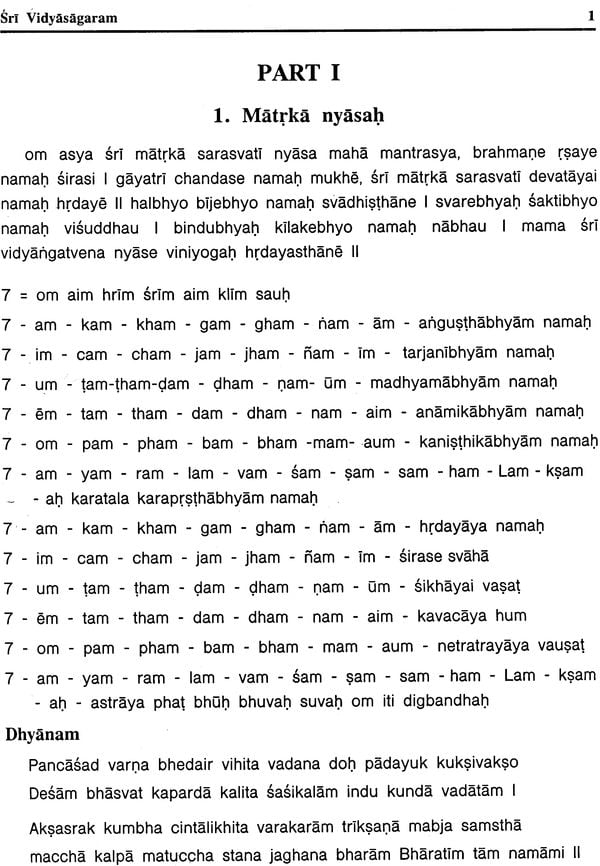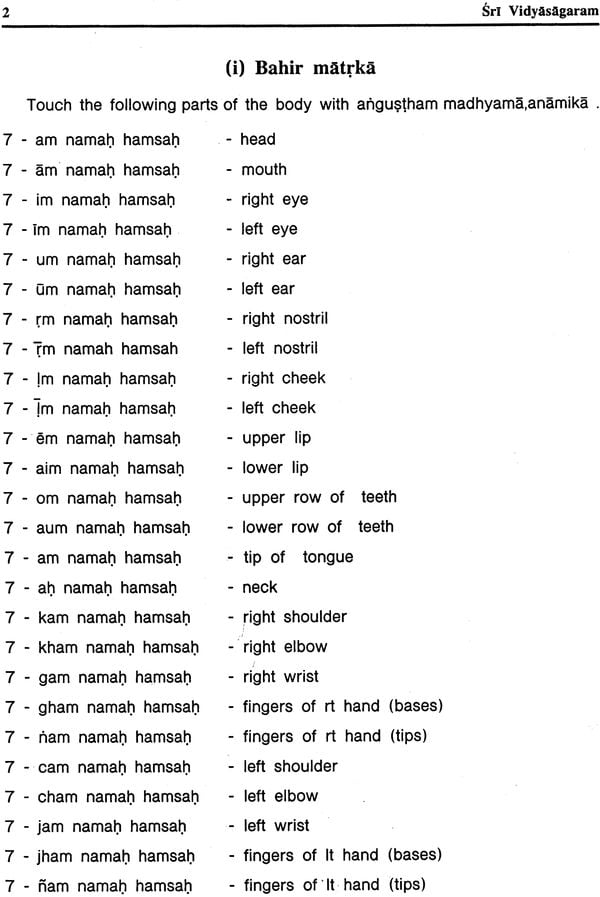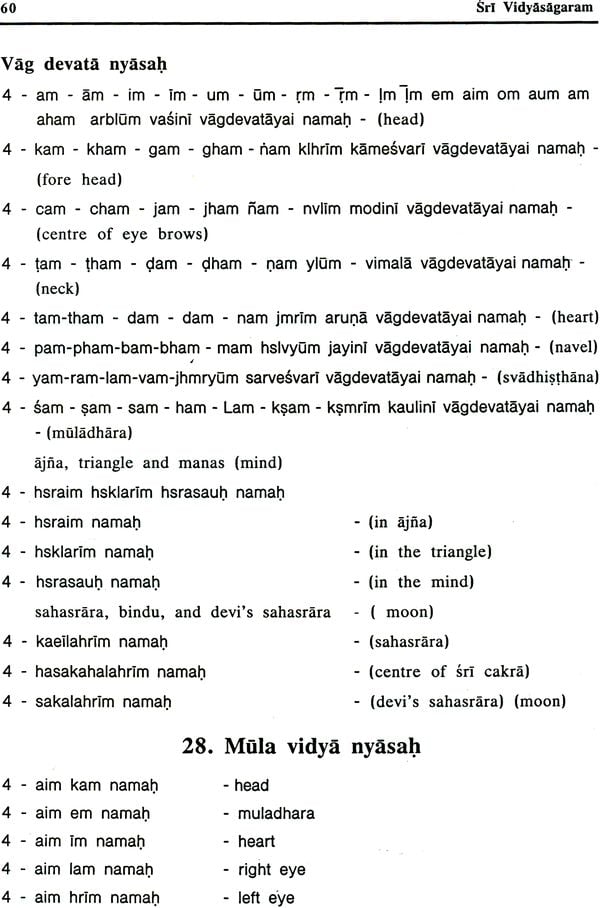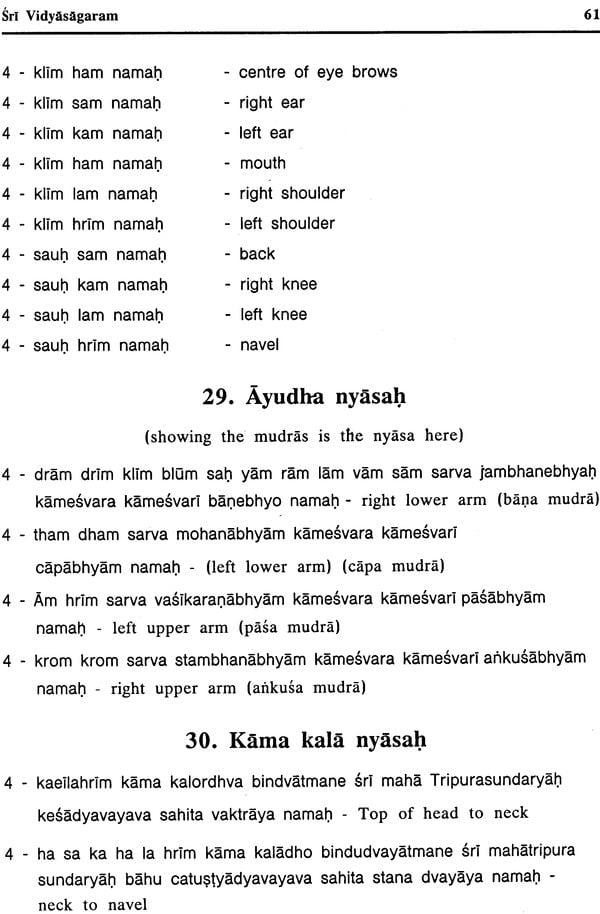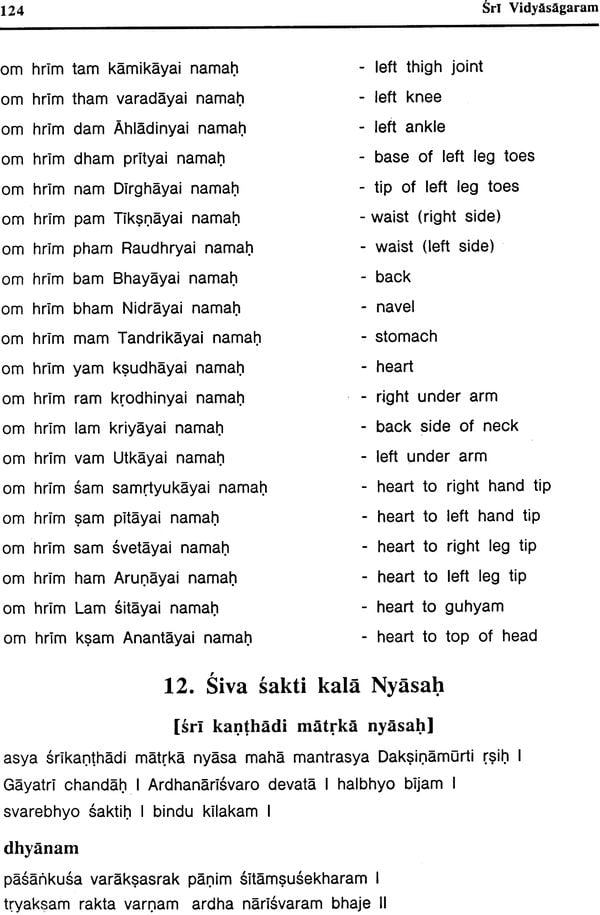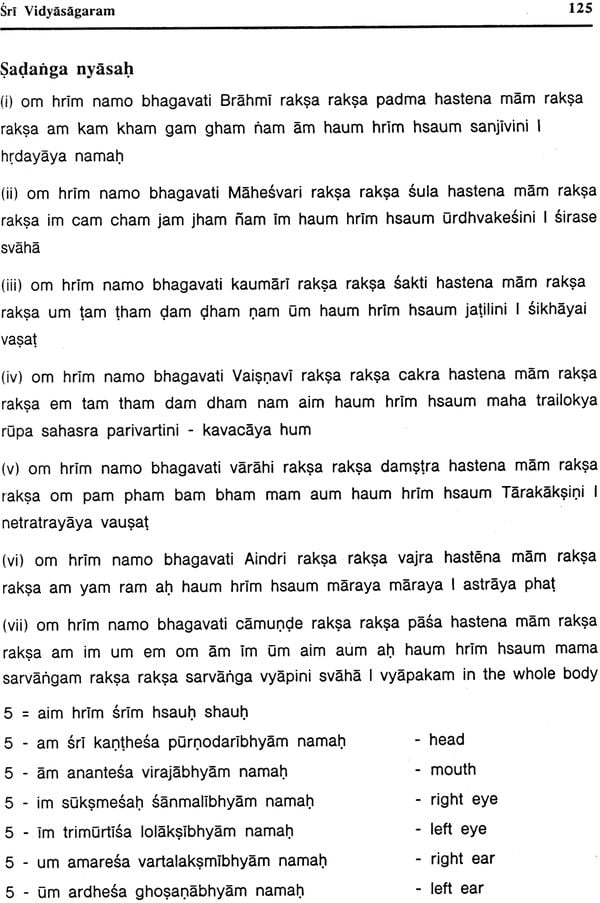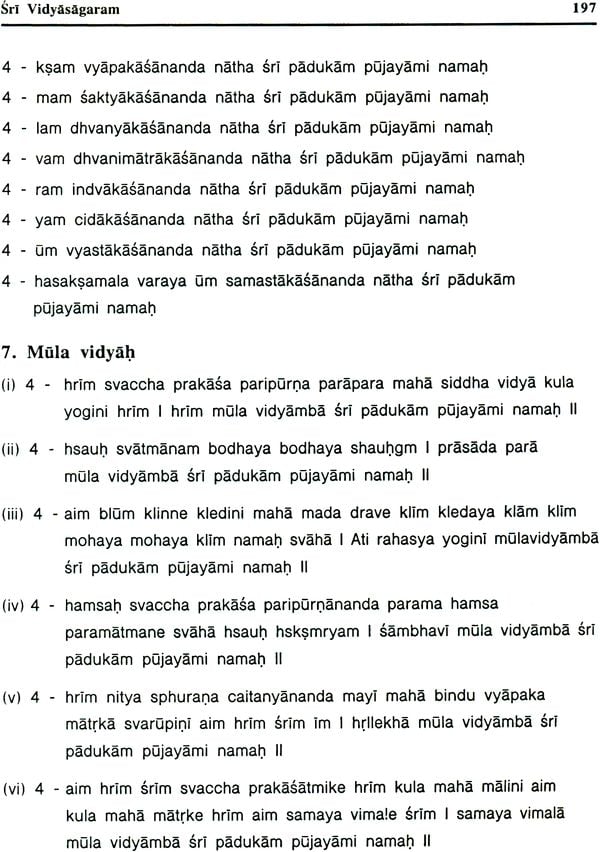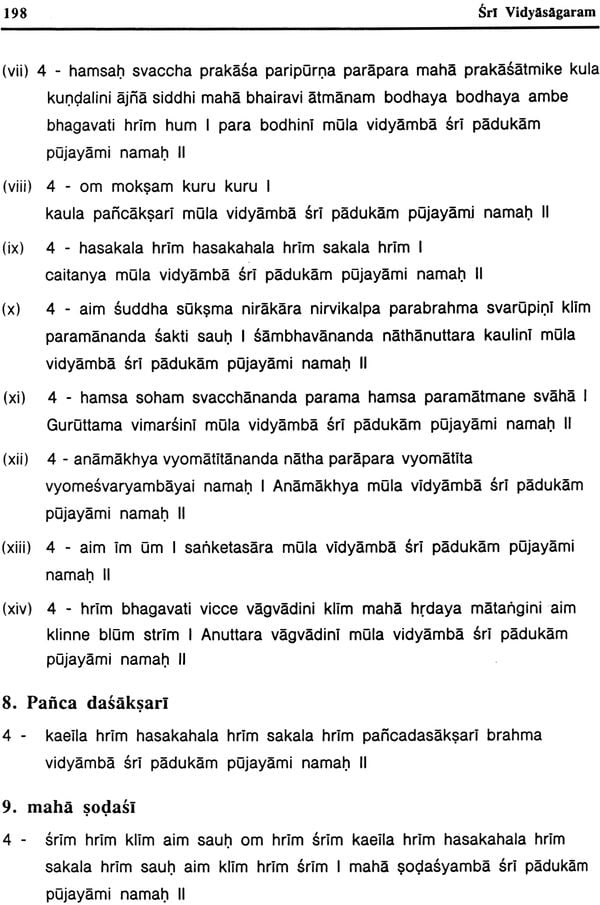
Sri Vidyasagaram - The Ocean of Shri Vidya (Transliteration with English)
Book Specification
| Item Code: | NAH229 |
| Author: | Atmananda Natha |
| Publisher: | Sri Vidya Temple Society |
| Language: | Transliteration with English |
| Edition: | 2013 |
| Pages: | 210 |
| Cover: | Paperback |
| Other Details | 11 inch X 8 inch |
| Weight | 460 gm |
Book Description
With Devi’s grace, the compilation “Sri Vidyasagaram” is being released in English. It has three divisions. The first one covers the various nyasa procedures. The second one has three mala mantras and the third division gives the mantras for pujas in the amnayas. All the three can be used by pancadasi / shodasi upasakas.
Nyasam-Sri Vidya upasana has integrated the rituals to be done physically and mentally. One of these is bhavana, a mental practice. Initial practices, which are mental in nature are Japa and pooja, which later will mature into bhavana. One of the essential rituals to acquire this bhavana is nyasa. Nyasa means to “place”. “To Place” the divine energy in the form of matrka or mantra aksharas on certain specific parts of the physical body is recommended. Although it appears that these are parts of the aspirant’s physical body, they indeed represent the subtle body which is being tuned by the placement of these mantra aksharas. Hence we can infer that the subtle (sukshma) body will become mantra maya or attain a devata maya. Earlier the gross body in bhuta shuddi was made divine; now the subtle body is made so and identified with the devata through mantra aksharas. We can see the removal of mayika mala, the notion of duality by the vidya tatvas, by which our own subtle body becomes the mantra maya swarupa of the adored deity.
Bhagavan Parasurama has, in his kalpa sutra referred to nyasas as “vajra kavacam”. Nyasas are capable of bestowing the benefit derived by wearing an armour made of diamond. Since diamond is a hard substance, an armour made of diamond helps one in facing serious problems and protects the physical body.
Sri Bhaskararaya in his “Bahya Varivasya Prakasa” has mentioned that upasakas who are unable to do the nyasas during their daily puja timings, can perform these at night time also. Therefore it is implied that the nyasas have to be done every day. Further, Kaula gita, while defining the greatness of a upasaka, describes an upasaka as one who does “aseeti nyasa” (80 nyasas), which indicates the importance and significance of these nyasas.
Mala Mantra-Three types of mala mantra have been included in this book. Each one is made up of a thousand letters (sahasraksharam). They have been taken from the text “Vidyarnavam”. The mala mantra “sahasrakshari vidya” is given in “Lalitopakhyanam” as well. This is a varied version of the Khadgamala commonly chanted every day.
Amnaya-Amnayam means a path or way. During mandira puja we percerve the four entrances in the four directions to the Sri cakra to be in this form. All the mantras have been distributed in six amnayas in Sri vidya. Amnayam may also be taken to mean “vedas”, either as the veda such as rig or as the collection of mantras in it. It is appropriate to consider that the first four amnayas represent the four vedas, the fifth amnayam the upanishats and the sixth amnayam the experiences accrued from the upanishats, In each amnayam there are mantras pertaining to guru mandalas and devatas. The pancadasi upasakas can perform their pujas in the first four amnayas; .The other two amnayas are spread in the bindu and all around the entire Sri cakra. Only Shodasi upasakas have the authority to perform pujas in these two amnayas. We offer our grateful prayers to Sri Rajarajeswari for bestowing Her grace and enabling the compilation and release of this malar during Navaratri.
Sri Rajarajeswari Peetam has great pleasure in releasing as its 38th Navaratri malar, “Sri Vidyasagaram” in English for the benefit of its devotees.
This book covers important set of topics and there has been growing interest in an English edition. There are three significant areas of Sri vidya in this compilation, (1) the nyasas to be done by the upasakas, (2) the mala mantras and (3) the mantras in the amnayas which will enable the upasakas to do detailed pujas.
We are grateful as always to Sri Atmananda natha, who has been rendering great service to upasakas by his guidance. We thank Guruguhamba and Kriyananda for their contribution in the preparation of this malar, and Smt. Geetha Karthikeyan for her help in the transliteration. Devi’s blessings and our gratitude are due to Smt.Jyothi and Sri Sunil for their excellent job in type setting and to Sri Lakshminarayanan of Maruthi Graphics for his continued help in getting the malar printed in a short time.
| Introduction | vii | |
| Preface | viii | |
| PART - I | ||
| 1. | Matrka Nyasah | 1 |
| 2. | Samhara Nyasah | 5 |
| 3. | Srsti Nyasah | 7 |
| 4. | Sthiti Nyasah | 9 |
| 5. | Dasavida Matrka Nyasah | 11 |
| 6. | Kesavadi Nyasah | 39 |
| 7. | Tripura Nyasah | 42 |
| 8. | Kama Rati Nyasah | 44 |
| 9. | Mula mantra Nyasah | 46 |
| 10. | Kara suddhi Nyasah | 47 |
| 11. | Atma Raksa Nyasah | 47 |
| 12. | Bala sadanga Nyasah | 47 |
| 13. | Caturasana Nyasah | 48 |
| 14. | Sadasana Nyasah | 48 |
| 15 | Navasana Nyasah | 48 |
| 16. | Bala yoga sadanga Nyasah | 49 |
| 17. | Sadanga Yuvati Nyasah | 49 |
| 18. | Vagdevata Nyasah | 49 |
| 19. | Bahir Navayoni Nyasah | 50 |
| 20. | Srnkhala Nyasah | 51 |
| 21. | Catus pitha Nyasah | 52 |
| 22. | Nava yogini Nyasah | 52 |
| 23. | Kamesvaryadi Nyasah | 53 |
| 24. | Tatvadi Devata Nyasah | 54 |
| 25. | Tatva Nyasah | 54 |
| 26. | Datta Samhitayam Pancadasi Nyasah | 55 |
| 27. | Vajra panjara Nyasah | 58 |
| 28. | Mula Vidya Nyasah | 60 |
| 29. | Ayudha Nyasah | 61 |
| 30. | Kamakala Nyasah | 61 |
| 31. | Laghu Sodha Nyasah | 62 |
| 32. | Sri Cakra Nyasah | 75 |
| 33. | Yoga Pitha Nyasah | 96 |
| PART II | ||
| 1. | Malini Nyasah | l04 |
| 2. | Sri Maha Sodasaksari Nyasah | 107 |
| 3. | Apara saubhagya Nyasah | 110 |
| 4. | Mukha kara Nyasah | 111 |
| 5. | Mukha pada Nyasah | 111 |
| 6. | Vaktra Nyasah | 112 |
| 7. | Maha saubhagya Nyasah | 113 |
| 8. | Astatrimsat sivakala Nyasah | 113 |
| 9. | Sambhavi kala Nyasah | 118 |
| 10. | Sattrimsat Tatva Nyasah | 119 |
| 11. | Sakti kala Nyasah | 122 |
| 12. | Sivasakti kala Nyasah | 124 |
| 13. | Maha sodha Nyasah | 127 |
| 14. | Astastaka Nyasah | 140 |
| 15. | Mahasakti Nyasah | 146 |
| PART - III | ||
| 1. | Prastara Sahasraksari. | 161 |
| 2. | Upasthana Sahasraksari. | 163 |
| 3. | Sri Sahasraksara Vidya | 165 |
| PART - IV | ||
| 1. | Amnaya Prakaranam | 168 |
